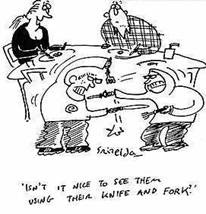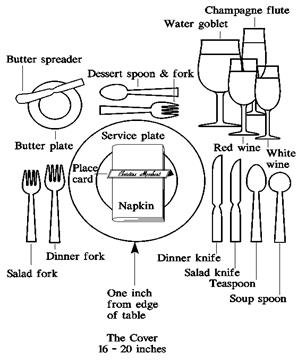Later ethnic and immigrant influence.
Mass migrations of immigrants to the United States came in several waves. Historians identify several waves of migration to the United States: one from 1815–1860, in which some five million English, Irish, Germanic, Scandinavian, and others from northwestern Europe came to the United States; one from 1865–1890, in which some 10 million immigrants, also mainly from northwestern Europe, settled, and a third from 1890–1914, in which 15 million immigrants, mainly from central, eastern, and southern Europe (many Austrian, Hungarian, Turkish, Lithuanian,Russian, Jewish, Greek, Italian, and Romanian) settled in the United States.
Together with earlier arrivals to the United States (including the indigenous Native Americans, Hispanic and Latino Americans, particularly in the West, Southwest, and Texas; African Americans who came to the United States in the Atlantic slave trade; and early colonial migrants from Britain, France, Germany, Spain, and elsewhere), these new waves of immigrants had a profound impact on national or regional cuisine. Some of these more prominent groups include the following:
· Irish Americans - Irish cuisine
· Italian Americans - Italian-American cuisine
· German Americans - German cuisine (the Pennsylvania Dutch, although descended from Germans, arrived earlier than the bulk of German migrants and have distinct culinary traditions)
· Scottish Americans - Scottish cuisine
· Greek Americans - Greek American cuisine, Greek cuisine, Mediterranean cuisine
· Portuguese Americans - Portuguese cuisine
· Romanian Americans - Romanian cuisine
· Polish Americans - Polish cuisine, with particular impact on Midwest
· Russian Americans - Russian cuisine, with particular impact on Midwest
· Lithuanian Americans - Lithuanian cuisine, with particular impact on Midwest
· American Jews - Jewish cuisine
· Indian Americans - Indian cuisine
· Pakistani Americans - Pakistani cuisine
· Japanese Americans - Japanese cuisine, with influences on the Hawaiian cuisine
· Polynesian Americans - Hawaiian cuisine
· West Indian Americans - Caribbean cuisine, Jamaican cuisine
· Cuban Americans - Cuban cuisine
· Chinese Americans - American Chinese cuisine, Chinese cuisine
· Vietnamese Americans - Vietnamese cuisine
· Arab Americans, particularly Lebanese Americans (the largest ethnic Arab group in the United States) - Arab cuisine, Lebanese cuisine
"Italian, Mexican and Chinese (Cantonese) cuisines have indeed joined the mainstream. These three cuisines have become so ingrained in the American culture that they are no longer foreign to the American palate. According to the study, more than nine out of 10 consumers are familiar with and have tried these foods, and about half report eating them frequently. The research also indicates that Italian, Mexican and Chinese (Cantonese) have become so adapted to such an extent that "authenticity" is no longer a concern to customers."
Contributions from these ethnic foods have become as common as traditional "American" fares such as hot dogs, hamburgers, beef steak, which are derived from German cuisine, (chicken-fried steak, for example, is a variation on German schnitzel), cherry pie, Coca-Cola,milkshakes, fried chicken (Fried chicken is of Scottish and African influence) and so on. Nowadays, Americans also have a ubiquitous consumption of foods like pizza and pasta, tacos and burritos to "General Tso's chicken" and fortune cookies. Fascination with these and other ethnic foods may also vary with region.
Notable American chefs.
American chefs have been influential both in the food industry and in popular culture. An important 19th Century American chef was Charles Ranhofer of Delmonico's Restaurant in New York City. American cooking has been exported around the world, both through the global expansion of restaurant chains such as T.G.I. Friday's and McDonald's and the efforts of individual restaurateurs such as Bob Payton, credited with bringing American-style pizza to the UK. The first generation of television chefs such as Robert Carrier and Julia Child tended to concentrate on cooking based primarily on European, especially French and Italian, cuisines. Only during the 1970s and 1980s did television chefs such as James Beard and Jeff Smith shift the focus towards home-grown cooking styles, particularly those of the different ethnic groups within the nation. Notable American restaurant chefs include Thomas Keller, Charlie Trotter, Grant Achatz, Alfred Portale, Paul Prudhomme, Paul Bertolli, Frank Stitt, Alice Waters, and celebrity chefs like Mario Batali, Alton Brown, Emeril Lagasse, Cat Cora, Michael Symon, Bobby Flay, Ina Garten, Todd English, Sandra Lee, Anthony Bourdain, and Paula Deen.
Regional chefs are emerging as localized celebrity chefs with growing broader appeal, such as Peter Merriman (Hawaii Regional Cuisine), Jerry Traunfeld, Alan Wong (Pacific Rim cuisine), Norman Van Aken (New World Cuisine - fusion Latin, Caribbean, Asian, African and American), and Mark Miller (American Southwest cuisine) (See Illustrations).
Illustrations.
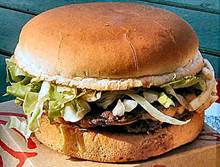


Apple pie is one of a number of American cultural icons.
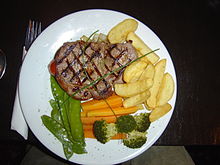

A sirloin steak dinner, served withsauteed onion, french fries, broccoli,carrots, and snow peas, garnished withchives.
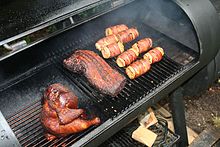

Chicken, pork and corn cooking in abarbecue smoker.
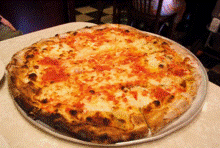

New York-style pizza.


Chicago-style deep-dish pizza from the original Pizzeria Uno location.
Cooking methods


Blue crab was used on the eastern and southern coast of what is now the U.S. mainland.
Seafood


Fish and chips served with coleslaw in the United States.


The American lobster was a staple of the colonial diet.


An American hot dog
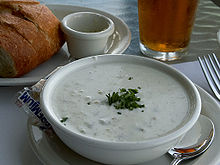

New England clam chowder


Fried fish and french fries in San Diego, California
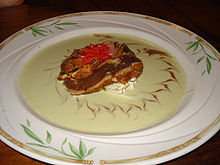

Hawaiian cuisine: Seared ahi withwasabi beurre blanc sauce


Fried chicken
1) “Table Manners”:
(http://www.ehow.com/how-to_4845381_improve-table-manners.html)
